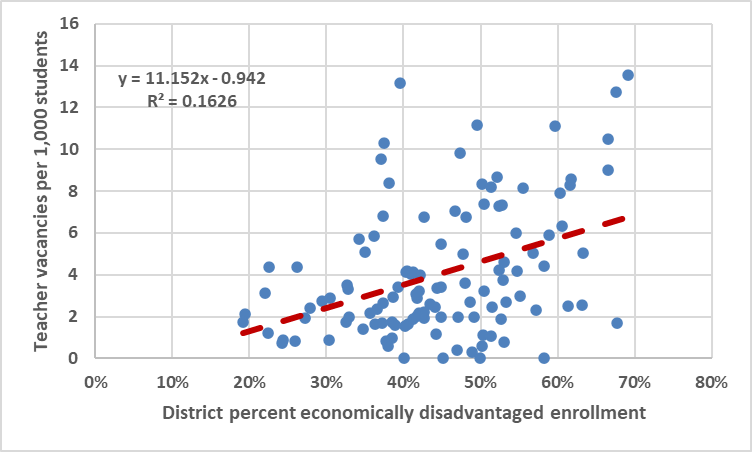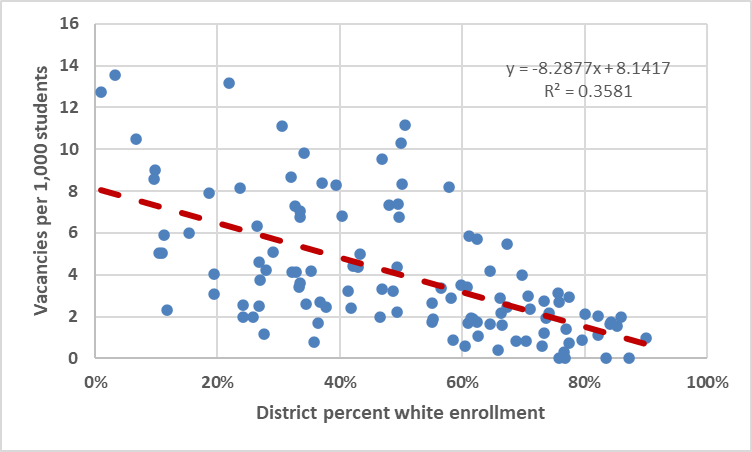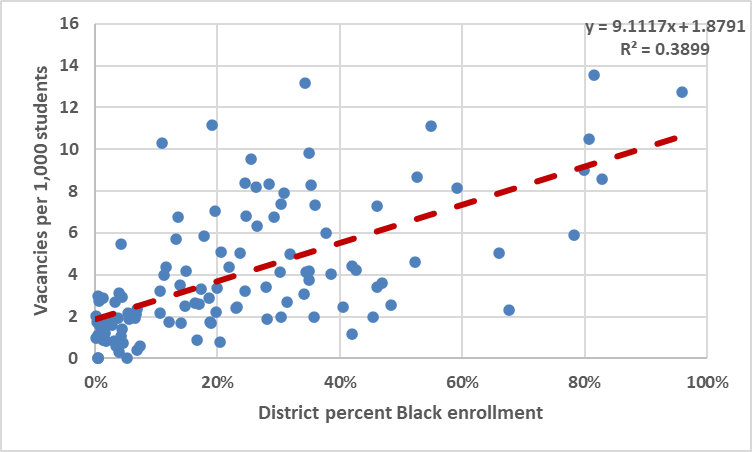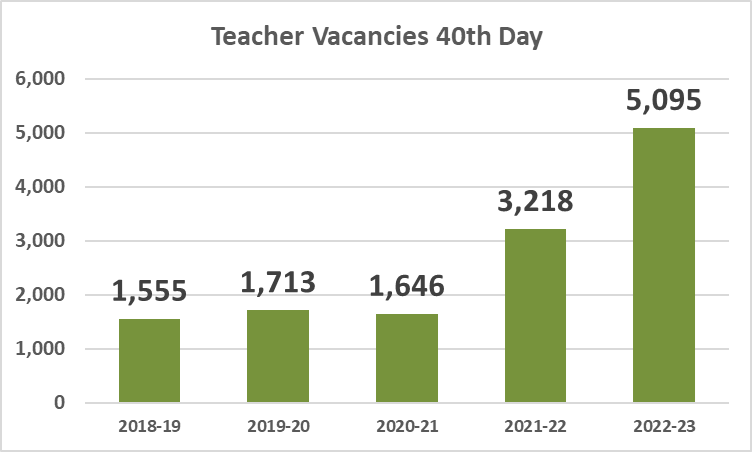At the beginning of the last school year, North Carolina faced an unprecedented teacher shortage. On the fortieth day of the 2022-23 school year, 5,095 classrooms were vacant. 1 In other words, nearly one in every 18 classrooms lacked an appropriately licensed teacher. Thanks to the actions (or lack thereof) of the General Assembly, schools are likely to face even more vacancies for the 2023-24 school year.
Schools that are unable to find qualified teachers may instead fill positions with untrained substitute teachers or novice teacher candidates who have yet to complete their licensure requirements. Of course, such instructors tend to be less effective than qualified, experienced teachers. The negative impacts on students are substantial, as research has shown that teacher quality is, unsurprisingly, the most important factor for student success. 2 3
When teachers aren’t available, some students might have to settle for virtual classes which are shown to be less effective than in-person learning.
The negative effects of teacher vacancies extend beyond the 5,095 classrooms lacking qualified teachers.
Vacancies often mean larger class sizes. In some cases, classes are combined and moved to larger spaces like gyms or cafeterias. Experienced teachers are regularly pulled from their classrooms to assist untrained, novice teachers. They might sacrifice a planning period to fill in when substitutes are nowhere to be found. Other teachers are forced to balance instructing the students in their own classroom, while also making their lessons accessible to remote classrooms of teacher-less students watching on video feed.
An increase in teacher shortages also means that schools are making hiring decisions from much shallower candidate pools. Even wealthy districts like Chapel Hill-Carrboro City Schools have struggled to find qualified applicants for open positions. 4 A shallow candidate pool means an overall reduction in teacher quality.
To make matters worse, vacancies are increasingly the result of teachers leaving in the middle of the year. Between the 2020-21 and 2021-22 school years, mid-year turnover increased from less than 4 percent to over 6 percent.5Such mid-year departures are especially disruptive to student development.6
Exacerbating racial and economic opportunity gaps
Teacher shortages tend to exacerbate the opportunity gaps between white students and students of color and between students whose families are wealthy or not. We’ve long known that schools and districts that enroll higher percentages of students of color and students from families with low incomes face greater challenges in recruiting and retaining teachers. The data on vacancies last year confirms this understanding.
District-level vacancies on the fortieth day of school are significantly correlated with both student race and income.
Districts serving greater shares of students from families with low incomes tend to have more teacher vacancies than districts with fewer students from families with low incomes. Every 10-percentage point increase in a district’s share of students from families with low incomes is associated with an increase of 1.1 classroom teacher vacancies per 1,000 students.
Figure 1: 22-23 district-level teacher vacancies (40th day) versus enrollment of economically disadvantaged students
The relationship between teacher vacancies and student race is, unfortunately, even stronger than the relationship with income. Districts tend to have lower vacancies as their population of white students increases. For every 10-percentage point increase in a district’s white enrollment, teacher vacancies decrease by 0.8 classroom teacher vacancies per 1,000 students.
Figure 2: 22-23 district-level teacher vacancies (40th day) versus enrollment of white students
By contrast, teacher vacancies increase in districts with higher shares of Black students. Every 10-percentage point increase in a district’s share of Black students is associated with an increase of 0.9 classroom teacher vacancies per 1,000 students.
Figure 3: 22-23 district-level teacher vacancies (40th day) versus enrollment of Black students
In total, the average district-level teacher vacancy rate for an economically disadvantaged student is 11 percent higher than it is for the average non-economically disadvantaged student. Similarly, the average Black student attends a district with a teacher vacancy rate that’s 16 percent higher than the district teacher vacancy rate of the typical white student.
Legislative leadership fails to offer solutions
One would expect that this dire situation would spur a response from legislators. Yet there have been no major efforts to reverse these trends. None appear forthcoming. Instead, legislators are likely making the problem worse by fanning the flames of racist and transphobic moral panics that make schools less welcoming environments for students and teachers alike.
A responsible legislature would make large, across-the-board salary increases the centerpiece of any effort to address teacher vacancies. For example, the court-ordered Leandro Comprehensive Remedial Plan mandates the legislature provide teachers with salaries competitive with other degree-requiring professions. Meeting this goal would require raises of nearly 25 percent.7 To put this number in context, simply adopting Alabama’s teacher salary schedule would provide North Carolina teachers with an average raise of 17.4 percent.8
Unfortunately, House and Senate budget proposals hardly keep pace with inflation. Their budget proposals would only raise teacher salaries in 2024 by between 2.3 and 5.3 percent.
Leaders could also dramatically improve teacher working conditions by implementing the Leandro Plan. The plan would provide teachers with the supplies, materials, and support staff necessary to help all students meet state achievement standards. Additionally, it would restore funding for professional development and the mentoring of early career teachers. The plan’s investments especially benefit high-poverty rural districts with the greatest challenges recruiting and retaining teachers.
Additionally, legislators have taken away many benefits from teachers over the past decade. Legislators could improve recruitment and retention by restoring career status, master’s pay, funding for National Board Certification applications, longevity pay, and retiree health benefits. They could further strengthen teacher benefits by granting teachers the authority to collectively bargain.
Focus instead is on moral panics that undermine public schools
A serious legislature would be trying all of the above to address these vital staffing challenges. Instead, they are focused instead on divisive responses to moral panics about how schools address issues related to race and sexuality. These moral panics have been created and promoted by right-wing think tanks as part of a deliberate campaign to undermine support for inclusive, well-resourced public schools.9
For example, HB 187 seeks to create a chilling effect around an honest teaching of history and current events. The bill prohibits teachers from “promoting” certain concepts around racism and other forms of discrimination. If it becomes law, the vague wording will undoubtedly lead many teachers to avoid instruction on controversial subjects.
Another bill, SB 49, prohibits instruction on “gender identity, sexual activity, or sexuality” in kindergarten through fourth grade and forces teachers to inform parents if a student wishes to change their name or pronouns.
Both SB 49 and Section 7.11 of the House Budget require radically new levels of “transparency” that threaten to tie up limited school resources responding to complaints from reactionary North Carolinians. New York Times columnist Jamelle Bouie insightfully describes these efforts as, “an institutionalization of the heckler’s veto, in which a single parent — or any individual, really — can remove hundreds of books or shut down lessons on the basis of that one person’s political discomfort.” 10
Research has shown that focus on these divisive issues exacerbates teacher staffing challenges. For example, high-quality teacher surveys indicate that such restrictions have “infringed on teachers’ autonomy,” and have “negatively affected their working conditions.”11
As Jennie Bryan, a 2021 North Carolina Teacher of the Year finalist from Brunswick County explained, “The targeting of teachers’ professional and academic integrity, the creation of controversies out of our curriculum in our highly politicized times has really almost absolutely broken the spirit of many of my colleagues.”12
Early signs point to a worsening problem
Teacher vacancies have exploded in the wake of the pandemic. Fortieth day vacancies have tripled from pre-pandemic levels.
Figure 4: 40th day teacher vacancies have risen dramatically
Data for the 2023-24 school year is just beginning to trickle in, but it points to a continued increase in vacancies. Charlotte-Mecklenburg Schools indicate that they are currently short 500 teaching positions, an increase of about 25 percent from the prior year.13 Brunswick County is reporting 31 teacher vacancies, up from just 14 in the previous year.14 Buncombe County is reportedly entering the school year with 26 vacancies, also up from 14 the prior year.15
North Carolinians will need to wait until early 2024 before the Department of Public Instruction publishes official, verified data on teacher vacancies for this school year. But we know right now that legislative leaders have failed to make any serious effort to address North Carolina’s unacceptably high level of teacher vacancies.
Footnotes
- The North Carolina Department of Public Instruction defines a teacher vacancy as “an instructional position (or a portion thereof) for which there is not an appropriately licensed teacher who is eligible for permanent employment.” See “2021-2022 State of the Teaching Profession in North Carolina,” as found at: https://www.dpi.nc.gov/districts-schools/districts-schools-support/district-human-capital/surveys-and-reports
- Chetty, Raj, John N. Friedman, and Jonah E. Rockoff. 2014. “Measuring the Impacts of Teachers I: Evaluating Bias in Teacher Value-Added Estimates.” American Economic Review, 104(9): 2593-2632, as found at: https://www.aeaweb.org/articles?id=10.1257/aer.104.9.2593
- Rockoff, Jonah, E. 2004. “The Impact of Individual Teachers on Student Achievement: Evidence from Panel Data.” American Economic Review, 94 (2): 247-252, as found at: https://www.aeaweb.org/articles?id=10.1257/0002828041302244
- Liz Schlemmer, “Two superintendents say the struggle to hire teachers is real, regardless of geography,” WUNC, July 28, 2022, as found at: https://www.wunc.org/education/2022-07-28/two-superintendents-say-the-struggle-to-hire-teachers-is-real-regardless-of-geography
- Kevin C. Bastian and Sarah Crittenden Fuller, “Educator Attrition and Hiring in North Carolina Public Schools. During the COVID-19 Pandemic,” Epic Insights, February 2023, as found at: https://epic.unc.edu/wp-content/uploads/sites/1268/2023/02/Educator-Attrition-and-Hiring-in-NC.pdf
- Matt Barnum, “New research shows just how much losing a teacher midyear hurts students,” Chalkbeat, October 23, 2018, as found at: https://www.chalkbeat.org/2018/10/23/21105948/new-research-shows-just-how-much-losing-a-teacher-midyear-hurts-students
- Sylvia Allegretto, “The teacher pay penalty has hit a new high” Economic Policy Institute, August 16, 2022, as found at: https://www.epi.org/publication/teacher-pay-penalty-2022/
- Kris Nordstrom, “Alabama is schooling North Carolina on teacher pay,” NC Policy Watch, July 7, 2022, as found at: Kris Nordstrom, “Alabama is schooling North Carolina on teacher pay,” NC Policy Watch, July 7, 2022, as found at: https://ncnewsline.com/briefs/alabama-is-schooling-north-carolina-on-teacher-pay/
- Kathryn Joyce, “The guy who brought us CRT panic offers a new far-right agenda: Destroy public education,” Salon, April 8, 2022, as found at: https://www.salon.com/2022/04/08/the-guy-brought-us-crt-panic-offers-a-new-far-right-agenda-destroy-public-education/
- Jamelle Bouie, “What the Republican Push for ‘Parents’ Rights’ Is Really About,” New York Times, March 28, 2023, as found at: https://www.nytimes.com/2023/03/28/opinion/parents-rights-republicans-florida.html
- Woo, Ashley, Sabrina Lee, Andrea Prado Tuma, Julia H. Kaufman, Rebecca Ann Lawrence, and Nastassia Reed, Walking on Eggshells—Teachers’ Responses to Classroom Limitations on Race- or Gender-Related Topics: Findings from the 2022 American Instructional Resources Survey, RAND Corporation, RR-A134-16, 2023. As found at: https://www.rand.org/pubs/research_reports/RRA134-16.html
- Keung Hui, “NC has a teacher shortage. Is ‘public vitriol’ against educators one of the reasons?” Raleigh News & Observer, February 17, 2022, as found at: https://www.newsobserver.com/news/local/education/article258428253.html
- Shamarria Morrison, “CMS short nearly 500 teachers,” WCNC Charlotte, August 8, 2023, as found at: https://www.wcnc.com/article/news/education/cms-schools-face-teacher-shortage-work-teachers-parents/275-cda651fc-5003-409e-9fc4-7c355c2d5c96
- Ava Brendgord, “Statewide teacher shortage leaves counties scrambling for new hires,” WECT News 6, August 15, 2023, as found at: https://www.wect.com/2023/08/14/statewide-teacher-shortage-leaves-counties-scrambling-new-hires/
- McKenna Leavens, “Asheville-area Democratic leaders call out state GOP on threats to public education,” Asheville Citizen Times, August 15, 2023, as found at: https://eu.citizen-times.com/story/news/local/2023/08/15/local-leaders-spoke-out-on-the-state-of-public-education-in-n-c/70576511007/
 Justice Circle
Justice Circle 


